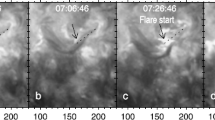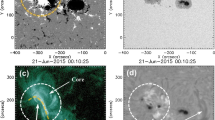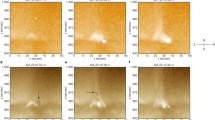Abstract
A solar eruptive event SOL2010-06-13 observed with the Atmospheric Imaging Assembly (AIA) of the Solar Dynamics Observatory (SDO) has been extensively discussed in the contexts of the CME development and an associated extreme-ultraviolet (EUV) wave-like transient in terms of a shock driven by the apparent CME rim. Continuing the analysis of this event, we have revealed an erupting flux rope, studied its properties, and detected wave signatures inside the developing CME. These findings have allowed us to establish new features in the genesis of the CME and associated EUV wave and to reconcile all of the episodes into a single causally related sequence. i) A hot 11 MK flux rope developed from the structures initially associated with a compact filament system. The flux rope expanded with an acceleration of up to 3 km s−2 one minute before a hard X-ray burst and earlier than any other structures, reached a velocity of 420 km s−1, and then decelerated to about 50 km s−1. ii) The CME development was driven by the expanding flux rope. Closed coronal structures above the rope got sequentially involved in the expansion from below upwards, came closer together, and apparently disappeared to reveal their common envelope, the visible rim, which became the outer boundary of the cavity. The rim was probably associated with the separatrix surface of a magnetic domain, which contained the pre-eruptive filament. iii) The rim formation was associated with a successive compression of the upper active-region structures into the CME frontal structure (FS). When the rim was formed, it resembled a piston. iv) The disturbance responsible for the consecutive CME formation episodes was excited by the flux rope inside the rim, and then propagated outward. EUV structures arranged at different heights started to accelerate, when their trajectories in the distance–time diagram were crossed by that of the fast front of this disturbance. v) Outside the rim and FS, the disturbance propagated like a blast wave, manifesting in a type II radio burst and a leading part of the EUV transient. Its main, trailing part was the FS, which consisted of swept-up 2 MK coronal loops enveloping the expanding rim. The wave decelerated and decayed into a weak disturbance soon afterwards, being not driven by the trailing piston, which slowed down.




















Similar content being viewed by others
References
Afanasyev, A.N., Uralov, A.M.: 2012, Solar Phys. 280, 561. DOI .
Afanasyev, A.N., Uralov, A.M., Grechnev, V.V.: 2013, Astron. Rep. 57, 594. DOI .
Alissandrakis, C.E., Kochanov, A.A., Patsourakos, S., Altyntsev, A.T., Lesovoi, S.V., Lesovoya, N.N.: 2013, Publ. Astron. Soc. Japan 65, SP1 S8. DOI .
Anzer, U.: 1978, Solar Phys. 57, 111. DOI .
Asai, A., Yokoyama, T., Shimojo, M., Masuda, S., Kurokawa, H., Shibata, K.: 2004, Astrophys. J. 611, 557. DOI .
Bain, H.M., Krucker, S., Glesener, L., Lin, R.P.: 2012, Astrophys. J. 750, 44. DOI .
Boerner, P., Edwards, C., Lemen, J., Rausch, A., Schrijver, C., Shine, R., Shing, L., Stern, R., Tarbell, T., Title, A., et al.: 2012, Solar Phys. 275, 41. DOI .
Brueckner, G.E., Howard, R.A., Koomen, M.J., Korendyke, C.M., Michels, D.J., Moses, J.D., Socker, D.G., Dere, K.P., Lamy, P.L., Llebaria, A., et al.: 1995, Solar Phys. 162, 357. DOI .
Carmichael, H.: 1964, In: Hess, W.N. (ed.) Proc. of AAS-NASA Symp. on the Physics of Solar Flares, NASA SP 50, 451.
Chen, J.: 1989, Astrophys. J. 338, 453. DOI .
Chen, J.: 1996, J. Geophys. Res. 1012, 27499. DOI .
Chen, B., Bastian, T.S., Gary, D.E.: 2014, Astrophys. J. 794, 149. DOI .
Chen, Y., Du, G., Feng, L., Feng, S., Kong, X., Guo, F., Wang, B., Li, G.: 2014, Astrophys. J. 787, 59. DOI .
Cheng, X., Zhang, J., Liu, Y., Ding, M.D.: 2011, Astrophys. J. Lett. 732, L25. DOI .
Cheng, X., Zhang, J., Ding, M.D., Liu, Y., Poomvises, W.: 2013, Astrophys. J. 763, 43. DOI .
Chertok, I.M., Belov, A.V., Grechnev, V.V.: 2015, Solar Phys. 290, 1947. DOI .
Dere, K.P., Brueckner, G.E., Howard, R.A., Koomen, M.J., Korendyke, C.M., Kreplin, R.W., Michels, D.J., Moses, J.D., Moulton, N.E., Socker, D.G., et al.: 1997, Solar Phys. 175, 601. DOI .
Downs, C., Roussev, I.I., van der Holst, B., Lugaz, N., Sokolov, I.V.: 2012, Astrophys. J. 750, 134. DOI .
Du, G., Chen, Y., Lv, M., Kong, X., Feng, S., Guo, F., Li, G.: 2014, Astrophys. J. Lett. 793, L39. DOI .
Dulk, G.A., McLean, D.J.: 1978, Solar Phys. 57, 279. DOI .
Eselevich, V., Eselevich, M.: 2012, Astrophys. J. 761, 68. DOI .
Eselevich, V.G., Eselevich, M.V.: 2013, Astron. Rep. 57, 860. DOI .
Feng, S.W., Chen, Y., Kong, X.L., Li, G., Song, H.Q., Feng, X.S., Guo, F.: 2013, Astrophys. J. 767, 29. DOI .
Gallagher, P.T., Lawrence, G.R., Dennis, B.R.: 2003, Astrophys. J. Lett. 588, L53. DOI .
Gary, G.A.: 2001, Solar Phys. 203, 71. DOI .
Gopalswamy, N., Nitta, N., Akiyama, S., Mäkelä, P., Yashiro, S.: 2012, Astrophys. J. 744, 72. DOI .
Grechnev, V.V., Uralov, A.M., Zandanov, V.G., Baranov, N.Y., Shibasaki, K.: 2006a, Publ. Astron. Soc. Japan 58, 69. DOI .
Grechnev, V.V., Uralov, A.M., Zandanov, V.G., Rudenko, G.V., Borovik, V.N., Grigorieva, I.Y., Slemzin, V.A., Bogachev, S.A., Kuzin, S.V., Zhitnik, I., Pertsov, A.A., Shibasaki, K., Livshits, M.A.: 2006b, Publ. Astron. Soc. Japan 58, 55. DOI .
Grechnev, V.V., Uralov, A.M., Slemzin, V.A., Chertok, I.M., Kuzmenko, I.V., Shibasaki, K.: 2008, Solar Phys. 253, 263. DOI .
Grechnev, V.V., Afanasyev, A.N., Uralov, A.M., Chertok, I.M., Eselevich, M.V., Eselevich, V.G., Rudenko, G.V., Kubo, Y.: 2011a, Solar Phys. 273, 461. DOI .
Grechnev, V.V., Uralov, A.M., Chertok, I.M., Kuzmenko, I.V., Afanasyev, A.N., Meshalkina, N.S., Kalashnikov, S.S., Kubo, Y.: 2011b, Solar Phys. 273, 433. DOI .
Grechnev, V.V., Kiselev, V.V., Uralov, A.M., Meshalkina, N.S., Kochanov, A.A.: 2013, Publ. Astron. Soc. Japan 65, SP1 S9. DOI .
Grechnev, V.V., Uralov, A.M., Slemzin, V.A., Chertok, I.M., Filippov, B.P., Rudenko, G.V., Temmer, M.: 2014a, Solar Phys. 289, 289. DOI .
Grechnev, V.V., Uralov, A.M., Chertok, I.M., Slemzin, V.A., Filippov, B.P., Egorov Ya, I., Fainshtein, V.G., Afanasyev, A.N., Prestage, N., Temmer, M.: 2014b, Solar Phys. 289, 1279. DOI .
Grechnev, V.V., Uralov, A.M., Kuzmenko, I.V., Kochanov, A.A., Chertok, I.M., Kalashnikov, S.S.: 2015, Solar Phys. 290, 129. DOI .
Hannah, I.G., Kontar, E.P.: 2012, Astron. Astrophys. 539, A146. DOI .
Hirayama, T.: 1974, Solar Phys. 34, 323. DOI .
Howard, R.A., Moses, J.D., Vourlidas, A., Newmark, J.S., Socker, D.G., Plunkett, S.P., Korendyke, C.M., Cook, J.W., Hurley, A., Davila, J.M., et al.: 2008, Space Sci. Rev. 136, 67. DOI .
Hudson, H.S., Webb, D.F.: 1997, In: Crooker, N., Joselyn, J.A., Feynman, J. (eds.) Coronal Mass Ejections, Washington DC American Geophysical Union Geophysical Monograph Series 99, 27. DOI .
Inhester, B., Birn, J., Hesse, M.: 1992, Solar Phys. 138, 257. DOI .
Kaiser, M.L., Kucera, T.A., Davila, J.M., St. Cyr, O.C., Guhathakurta, M., Christian, E.: 2008, Space Sci. Rev. 136, 5. DOI .
Knock, S.A., Cairns, I.H.: 2005, J. Geophys. Res. A 110, A01101. DOI .
Kochanov, A.A., Anfinogentov, S.A., Prosovetsky, D.V., Rudenko, G.V., Grechnev, V.V.: 2013, Publ. Astron. Soc. Japan 65, SP1, S19. DOI .
Kopp, R.A., Pneuman, G.W.: 1976, Solar Phys. 50, 85. DOI .
Kouloumvakos, A., Patsourakos, S., Hillaris, A., Vourlidas, A., Preka-Papadema, P., Moussas, X., Caroubalos, C., Tsitsipis, P., Kontogeorgos, A.: 2014, Solar Phys. 289, 2123. DOI .
Kozarev, K.A., Korreck, K.E., Lobzin, V.V., Weber, M.A., Schwadron, N.A.: 2011, Astrophys. J. Lett. 733, L25. DOI .
Kumar, P., Cho, K.-S., Bong, S.-C., Park, S.-H., Kim, Y.H.: 2012, Astrophys. J. 746, 67. DOI .
Kundu, M.R., Grechnev, V.V., White, S.M., Schmahl, E.J., Meshalkina, N.S., Kashapova, L.K.: 2009, Solar Phys. 260, 135. DOI .
Kwon, R.-Y., Zhang, J., Olmedo, O.: 2014, Astrophys. J. 794, 148. DOI .
Kwon, R.-Y., Zhang, J., Vourlidas, A.: 2015, Astrophys. J. Lett. 799, L29. DOI .
Kwon, R.-Y., Ofman, L., Olmedo, O., Kramar, M., Davila, J.M., Thompson, B.J., Cho, K.-S.: 2013, Astrophys. J. 766, 55. DOI .
Lemen, J.R., Title, A.M., Akin, D.J., Boerner, P.F., Chou, C., Drake, J.F., Duncan, D.W., Edwards, C.G., Friedlaender, F.M., Heyman, G.F., et al.: 2012, Solar Phys. 275, 17. DOI .
Levenberg, K.: 1944, Q. Appl. Math. 2, 164.
Livshits, M.A., Badalyan, O.G.: 2004, Astron. Rep. 48, 1037. DOI .
Longcope, D.W., Beveridge, C.: 2007, Astrophys. J. 669, 621. DOI .
Low, B.C.: 1982, Astrophys. J. 254, 796. DOI .
Ma, S., Raymond, J.C., Golub, L., Lin, J., Chen, H., Grigis, P., Testa, P., Long, D.: 2011, Astrophys. J. 738, 160. DOI .
Mancuso, S., Raymond, J.C.: 2004, Astron. Astrophys. 413, 363. DOI .
Mandrini, C.H., Pohjolainen, S., Dasso, S., Green, L.M., Démoulin, P., van Driel-Gesztelyi, L., Copperwheat, C., Foley, C.: 2005, Astron. Astrophys. 434, 725. DOI .
Mann, G., Klassen, A., Aurass, H., Classen, H.-T.: 2003, Astron. Astrophys. 400, 329. DOI .
Marquardt, D.W.: 1963, SIAM J. Appl. Math. 11, 431.
Meegan, C., Lichti, G., Bhat, P.N., Bissaldi, E., Briggs, M.S., Connaughton, V., Diehl, R., Fishman, G., Greiner, J., Hoover, A.S., et al.: 2009, Astrophys. J. 702, 791. DOI .
Meshalkina, N.S., Uralov, A.M., Grechnev, V.V., Altyntsev, A.T., Kashapova, L.K.: 2009, Publ. Astron. Soc. Japan 61, 791. DOI .
Miklenic, C.H., Veronig, A.M., Vršnak, B.: 2009, Astron. Astrophys. 499, 893. DOI .
Neupert, W.M.: 1968, Astrophys. J. Lett. 153, L59. DOI .
Patsourakos, S., Vourlidas, A., Stenborg, G.: 2010, Astrophys. J. Lett. 724, L188. DOI .
Plowman, J., Kankelborg, C., Martens, P.: 2013, Astrophys. J. 771, 2. DOI .
Qiu, J., Hu, Q., Howard, T.A., Yurchyshyn, V.B.: 2007, Astrophys. J. 659, 758. DOI .
Reiner, M.J., Vourlidas, A., St. Cyr, O.C., Burkepile, J.T., Howard, R.A., Kaiser, M.L., Prestage, N.P., Bougeret, J.-L.: 2003, Astrophys. J. 590, 533. DOI .
Saito, K.: 1970, Ann. Tokyo Astron. Obs. 12, 53.
Sedov, L.I.: 1981, Similarity Methods and Dimensional Analysis in Mechanics, 9th edn. Nauka, Moscow (in Russian).
Sheeley, N.R. Jr., Warren, H.P., Wang, Y.-M.: 2007, Astrophys. J. 671, 926. DOI .
Smerd, S.F., Sheridan, K.V., Stewart, R.T.: 1974, In: Newkirk, G.A. (ed.) Coronal Disturbances, IAU Symp. 57, Reidel, Dordrecht, 389.
Sterling, A.C., Hudson, H.S.: 1997, Astrophys. J. Lett. 491, L55. DOI .
Sturrock, P.A.: 1966, Nature 211, 695. DOI .
Temmer, M., Veronig, A.M., Vršnak Rybák, J., Gömöry, J., Stoiser, S., Maričić, D.: 2008, Astrophys. J. Lett. 673, L95. DOI .
Temmer, M., Veronig, A.M., Kontar, E.P., Krucker, S., Vršnak, B.: 2010, Astrophys. J. 712, 1410. DOI .
Torii, C., Tsukiji, Y., Kobayashi, S., Yoshimi, N., Tanaka, H., Enome, S.: 1979, Proc. Res. Inst. Atmos. 26, 129.
Uralov, A.M.: 1990, Solar Phys. 127, 253. DOI .
Uralov, A.M., Grechnev, V.V., Hudson, H.S.: 2005, J. Geophys. Res. 110, A05104. DOI .
Uralov, A.M., Lesovoi, S.V., Zandanov, V.G., Grechnev, V.V.: 2002, Solar Phys. 208, 69. DOI .
Uralov, A.M., Grechnev, V.V., Rudenko, G.V., Myshyakov, I.I., Chertok, I.M., Filippov, B.P., Slemzin, V.A.: 2014, Solar Phys. 289, 3747. DOI .
Uralova, S.V., Uralov, A.M.: 1994, Solar Phys. 152, 457. DOI .
van Ballegooijen, A.A., Martens, P.C.H.: 1989, Astrophys. J. 343, 971. DOI .
Vasanth, V., Umapathy, S., Vršnak, B., Žic, T., Prakash, O.: 2014, Solar Phys. 289, 251. DOI .
Vršnak, B., Cliver, E.W.: 2008, Solar Phys. 253, 215. DOI .
Vršnak, B., Maričić, D., Stanger, A.L., Veronig, A.M., Temmer, M., Roša, D.: 2007, Solar Phys. 241, 85. DOI .
Wang, Y., Zhang, J., Shen, C.: 2009, J. Geophys. Res. 114, 10104. DOI .
Warmuth, A.: 2015, Living Rev. Solar Phys. 12, 3. DOI .
Warmuth, A., Vršnak, B., Aurass, H., Hanslmeier, A.: 2001, Astrophys. J. Lett. 560, L105. DOI .
Webb, D.F., Lepping, R.P., Burlaga, L.F., DeForest, C.E., Larson, D.E., Martin, S.F., Plunkett, S.P., Rust, D.M.: 2000, J. Geophys. Res. 105, 27251. DOI .
Yashiro, S., Gopalswamy, N., Michalek, G., St. Cyr, O.C., Plunkett, S.P., Rich, N.B., Howard, R.A.: 2004, J. Geophys. Res. 109, A07105. DOI .
Zhang, J., Cheng, X., Ding, M.-D.: 2012, Nat. Commun. 3, 747. DOI .
Zhang, J., Dere, K.P., Howard, R.A., Kundu, M.R., White, S.M.: 2001, Astrophys. J. 559, 452. DOI .
Zimovets, I., Vilmer, N., Chian, A.C.-L., Sharykin, I., Struminsky, A.: 2012, Astron. Astrophys. 547, A6. DOI .
Acknowledgements
We thank S.A. Anfinogentov, N.S. Meshalkina, and M.V. Eselevich for their assistance in data handling; and A. Kouloumvakos with co-authors and M.A. Livshits for useful discussions. We are indebted to an anonymous reviewer for the cooperation in bringing this article to its final form. We thank the instrumental teams operating AIA and HMI on SDO, STEREO/SECCHI, Fermi, SOHO/LASCO, Nobeyama Solar Facilities, NICT, USAF RSTN network, and GOES satellites for the data used here. The CME catalog used in this article is generated and maintained at the CDAW Data Center by NASA and The Catholic University of America in cooperation with the Naval Research Laboratory. SOHO is a project of international cooperation between ESA and NASA. This study was supported by the Program of Basic Research No. II.16.1.6, the Integration Project of RAS SD No. 4, and the Russian Foundation of Basic Research under grants 15-02-01077, 15-02-01089, and 15-32-20504-mol-a-ved.
Author information
Authors and Affiliations
Corresponding author
Electronic Supplementary Material
Below are the links to the electronic supplementary material.
Rights and permissions
About this article
Cite this article
Grechnev, V.V., Uralov, A.M., Kochanov, A.A. et al. A Tiny Eruptive Filament as a Flux-Rope Progenitor and Driver of a Large-Scale CME and Wave. Sol Phys 291, 1173–1208 (2016). https://doi.org/10.1007/s11207-016-0888-z
Received:
Accepted:
Published:
Issue Date:
DOI: https://doi.org/10.1007/s11207-016-0888-z




